Redefining Social Media: How Far Are We from Web3?
Author: NFTGo
Key Takeaway
Web2 social media has a monopolistic position in traffic, while Web3 introduces variables that allow users to lead product development. At the same time, social media giants are entering the NFT space and trying to integrate it with their business scenarios.
NFTs and social media have a "symbiotic" relationship, and NFTs can also serve as an expansion weapon for social media.
During the transition from Web2 to Web3, information distribution and organizational structures will change, and the functions of Web3 social products will be upgraded accordingly: for example, personal social base stations based on SBT, customized SocialFi.
Web3 brings a decentralized information distribution model and immersive interaction experience, prompting people to rethink the essence of socializing.
1. The New Trend of Social Media: Web3
Web2 social media occupies a dominant position in data traffic, from Facebook and YouTube to Twitter and TikTok. Different information distribution models have spawned new industries, businesses, and professions, leading to multiple consumption upgrades while directing massive funds to social media giants.
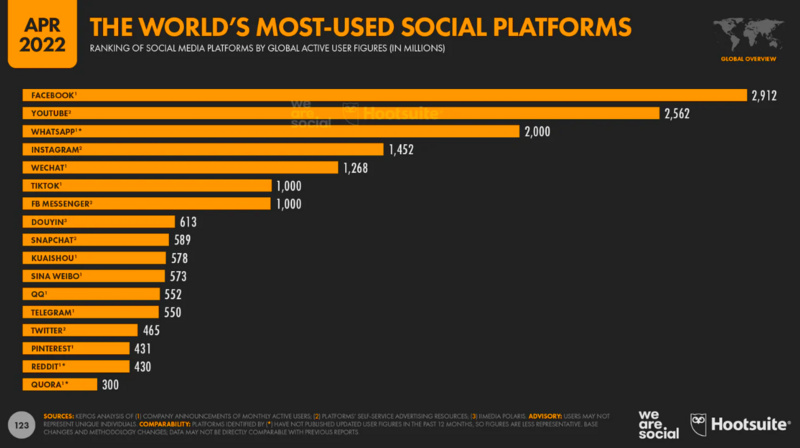
Social Media User Data (Source: datareportal)
To date, the main competitiveness of social media has shifted from "product optimization" to "content is king," and the business model has gradually solidified into "information flow advertising," all monetized through user attention and behavioral data. However, this model has also sparked some contradictions: how to balance user interests, data security, and the commercialization of attention? For creators, in the era of content being king, they have to rely on platforms for survival—this is somewhat unreasonable.
The development of blockchain and NFTs has introduced some more interesting concepts: such as SocialFi, NFTs, DAOs, etc. With the advantages of data autonomy and decentralization, the crypto industry has gradually cultivated a new user consciousness characterized by information transparency, cultural freedom, and community autonomy.
For these traditional social media platforms, they also understand that Web3 is the next trend. However, traditional social media giants face challenges such as "too large to accelerate easily" and "regulatory scrutiny," so they can only attempt to advance gradually and tentatively.
This time, we let Web3 users lead product development.
Let's take a look at what Web2 companies have tried.
2. The Open Competition Among Giants
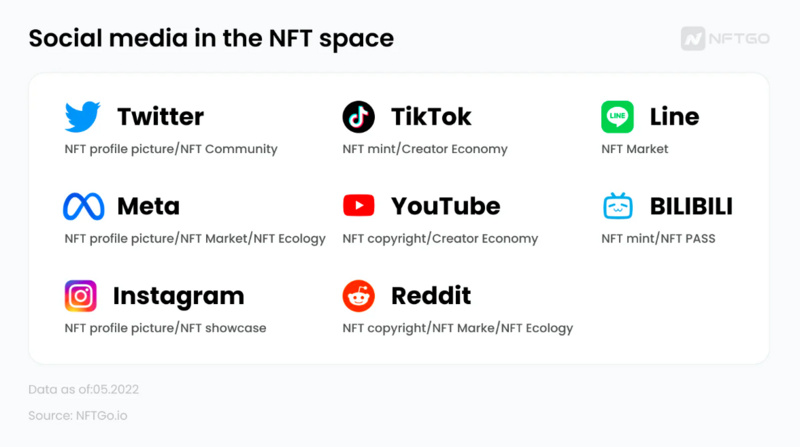
Exploring the NFT Field in Social Media
2.1 Twitter
It must be said that most current information about NFTs is still based on Twitter. Since Jack Dorsey, Twitter has intentionally included crypto as a major part of its future business, establishing a dedicated team for NFT business exploration last year. Twitter has also become one of the first social media platforms to allow users to showcase their NFTs as profile pictures and support multiple crypto wallets.
Notably, Twitter attempted to issue its own NFTs last year, but it did not yield results for various reasons. According to insiders, Twitter's next step will be to strengthen the influence of NFT communities.
2.2 Meta
After Facebook rebranded to Meta, its goal is to create the world's largest social media metaverse, and its actions have been quite rapid. Following Twitter, Meta announced the establishment of its own NFT ecosystem, launching a feature that allows users to display NFT avatars on its main products, Facebook and Instagram. Additionally, Meta aims to simplify the complexities of buying and selling digital assets, using its payment infrastructure to establish a marketplace that includes NFTs.
2.3 Instagram
Instagram recently launched NFT display features, including connecting digital wallets, NFT artwork recognition, and proof of NFT ownership. Zuckerberg also stated that in the coming months, Instagram will allow users to bring their NFTs into the social platform and will further explore the possibility of minting NFTs, indicating that its primary audience is creators and collectors.
2.4 TikTok
TikTok partnered with ImmutableX last year to launch TikTok Top Moments, a series of NFTs targeting influential creators and their popular videos, turning their highlights into NFTs for sale, with revenue directed to content creators and NFT artists.
Additionally, in collaboration with the music NFT platform Audius, TikTok developed a new feature called TikTok Sounds, allowing Audius users to export their music NFTs to TikTok. Officials hope that TikTok can become a social platform that rewards creators through innovative means in the future.
2.5 YouTube
As the world's largest video platform, YouTube has been researching the integration of NFTs with the creator economy. Colin Fitzpatrick, CEO of Animal Concerts, described YouTube's potential NFT integration as "a great way for creators to monetize their channels without relying on ad revenue." CEO Susan Wojcicki also stated, "We will continue to enhance and improve the experience for creators and fans on YouTube using technologies like NFTs."
2.6 Reddit
Following Twitter, Reddit also launched NFT avatar features and introduced its own NFT collectibles last year. Additionally, based on a previous Reddit job posting, it is speculated that Reddit is intentionally building its own NFT marketplace, indicating that Reddit is a relatively proactive social media platform in the Web3 industry.
Interestingly, internal data from Reddit for 2021/2022 shows that 85% of Reddit users are more familiar with NFTs than the average internet user, far exceeding Twitter users at 39% and Instagram users at 17%.
The above social media giants have all made some moves, with a commonality of attempting to integrate NFTs into their social media businesses based on their main platform functionalities. For example, Twitter focuses on social interaction and opinion discussions, hence its NFT avatar display feature; Instagram leans towards status sharing and images, thus entering from NFT artwork display; while TikTok and YouTube, which inherently have incentive functions, have been integrating NFTs with the creator economy.
3. The Relationship Between NFTs and Social Media
3.1 Symbiosis
Currently, the methods for acquiring users through social media are still prevalent in Web3: community fission, KOL collaboration, media promotion. These methods require upfront funding to incentivize users, such as community fission, where existing users actively pull in new users and provide points as subsidies, or KOL collaboration, where video bloggers and social media influencers collaborate for soft advertising recommendations.
At this point, doesn't it feel like the promotional aspects of NFTs are quite similar to the above methods? Today's NFT project teams still build value on social media, meaning most project teams need to publish content on Twitter and Discord to explain what they have done and what they plan to do. This creates a somewhat paradoxical situation: the value presentation of Web3 NFTs relies on Web2 social media, leading to the most critical question ------the promotion of NFT value cannot be separated from social media. To exaggerate, if Twitter does not recognize its legitimacy, NFT project teams will suffer a loss in value.
Of course, there may be alternative solutions. Social media should proactively bind its value with Web3 by attracting and collaborating with more NFT project teams, thereby achieving expansion in the Web3 domain.
So how can one bind their value with Web3 to achieve expansion?
3.2 Expansion
Although NFTs and social media have a symbiotic relationship, there has always been competition among social media platforms. Whoever can leverage NFTs to form a competitive edge and seize high ground will become the next super giant.
The current stage can be termed the initiation phase, as the aforementioned social media giants are all making exploratory integrations but primarily focus on their own experiments. Currently, no one has formed a lethal competition against their rivals. In the subsequent expansion phase, social media platforms are likely to issue their own NFTs to capture users. This will be the best way to accurately identify their user groups and retain users, who will enjoy social media services by holding NFTs.
NFTs used as expansion weapons will have more lethal potential. We can explore several possible directions:
(1) From Social to Cultural Output
NFT holders form community organizations through discourse consensus and identity recognition, voicing their interests on social media. From a sociological perspective, human beings gather, communicate, and ultimately develop group consciousness, which is the narrow sense of "culture." Therefore, the community culture generated from gathering will become a powerful cultural competitiveness for social media, with NFTs serving as the totem for dissemination, allowing social media's community culture to spread in the form of "transactions," thereby creating a positive cycle to expand their user base.
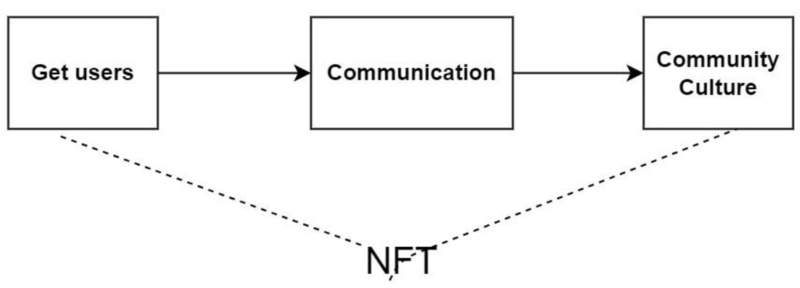
Community culture acquiring users through NFTs
(2) Strengthening the Ecosystem through PASS
Traditional social media has always been focused on acquiring C-end users through various means, using this as leverage to negotiate advertising collaborations with B-end enterprises. Currently, a feasible approach is to issue their own NFTs, attracting project teams and community groups through PASS mechanisms. The benefit of this is that it allows social media to rapidly build its own NFT ecosystem in the Web3 domain, not only acquiring users from other projects but also expanding the rights of its own users, thereby improving user retention.
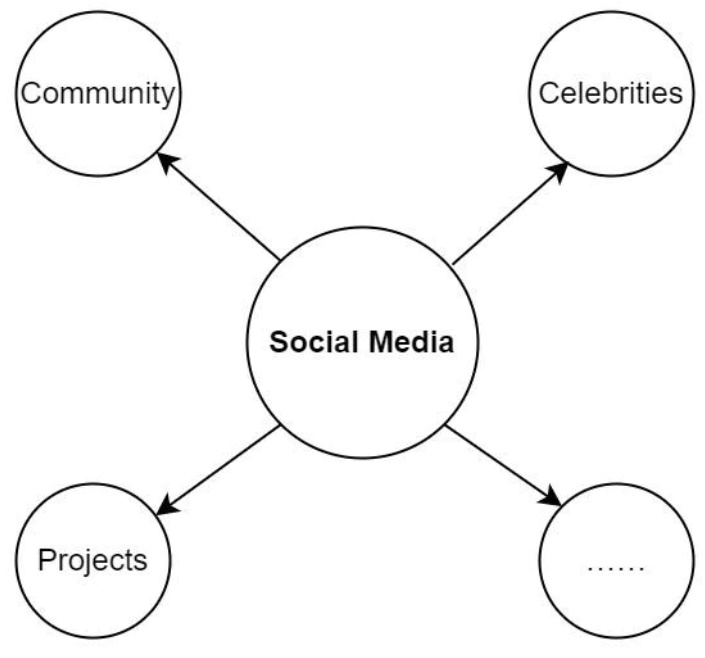
Social Media NFT Network
(3) Seizing Content High Ground (NFT Copyright)
High-quality content IP has always been a "must-fight" area in Web2. In Web3, high-quality creators' NFTs and high-quality community NFTs will become the winning tools for traffic. Whoever seizes them first will gain a first-mover advantage. Therefore, many social media platforms have been cultivating the soil for content production, building NFT creation platforms and NFT markets. For community groups, they can bind interests through collaboration, such as interacting with some quality communities through NFTs, thereby expanding their ecosystem as much as possible while securing the potential for future content development of quality NFTs.
4. Vision for Web3 Social Media
4.1 Evolution of Information Distribution Models
One of the fundamental differences between Web2 and Web3 social media lies in the different information distribution models. In Web2, we are familiar with personalized recommendations under intelligent recommendation algorithms. Content is generated through PGC and UGC models, and then centralized social media platforms provide personalized recommendations based on user tags.
In Web3, information dissemination leans more towards social recommendations, following the six degrees of separation principle, where individuals become central nodes for information distribution. Creators possess DAOs centered around themselves, distributing content and NFTs to fans, with token rewards facilitated through smart contracts.
Of course, there will be an intermediate state during the transition from Web2 to Web3, which we are currently experiencing and can tentatively call Web2.5. This phase is characterized by a blend of social media, DAOs, Web2 users, and Web3 users. The platform's role will gradually diminish, replaced by DAOs that gather around content culture. Platforms will attract creators and users through NFTs, and creators will distribute content and interact with fans by holding NFTs issued by the platform, gradually introducing token incentive designs and DAO governance. Everyone can create value, distribute value, and quantify value.
The following diagram illustrates the evolution of different information distribution models over time.
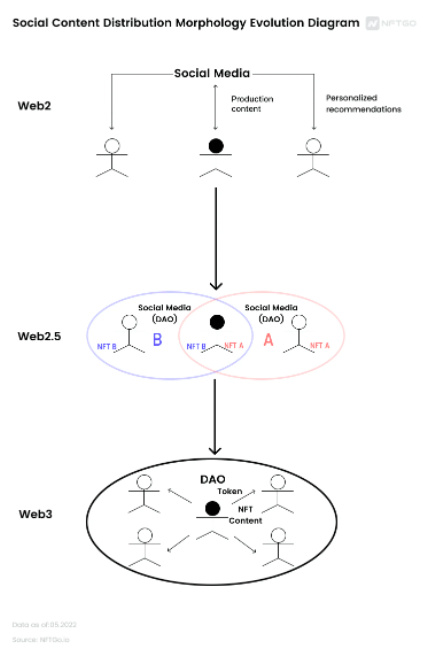
Evolution of Social Content Distribution Forms
4.2 Comparison of Social Media Characteristics
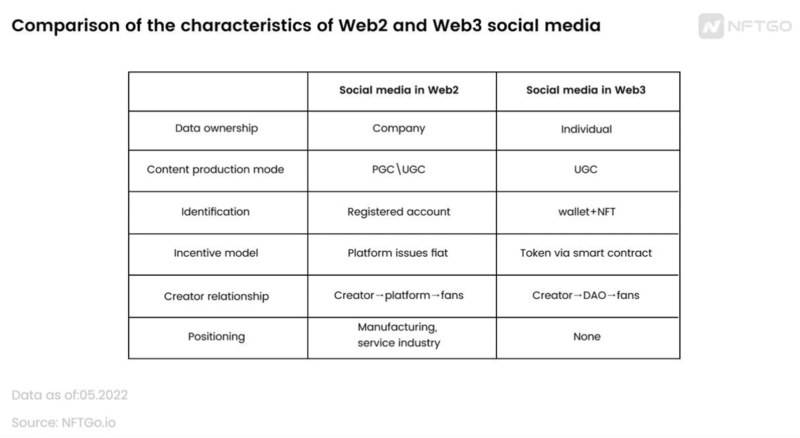
Comparison of Characteristics Between Web2 and Web3 Social Media
In Web3 socializing, individuals will no longer rely on social platforms; instead, everyone becomes the center of content distribution, primarily using unified personal accounts, possessing complete freedom over personal data. When interacting with others, the interaction behavior is saved and recorded within their own ecosystem. We also see some protocols like Lens Protocol attempting to build social platforms based on accounts.
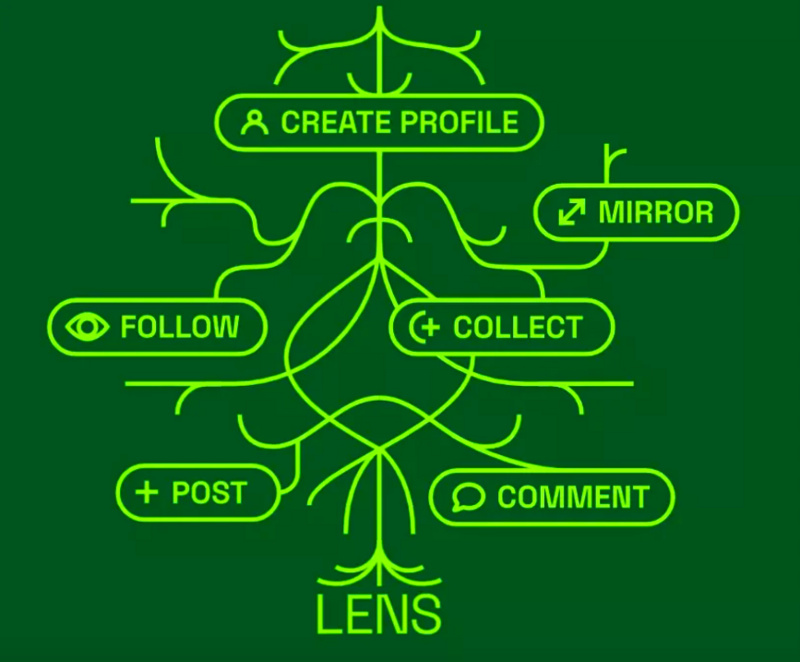
Concept Diagram of Lens Protocol
In addition to the changes at the protocol level, there are significant issues at the application level. Currently, some SocialFi projects, such as Monaco, BitClout, and oneof, can verify wallets, allowing users holding NFTs to register accounts and receive token rewards for interactions on the site. However, they still exist as information islands, and their reward mechanisms vary. Perhaps people can build their own social platforms through integrated SocialFi, as each person's social model is different, allowing users to choose customized SocialFi solutions based on their data.
4.3 About Content Distribution Rights
Many believe that platforms controlling content distribution rights and user data is not necessarily a bad thing, as without platforms, our efficiency in filtering information would greatly decline, making it difficult for people to discover interesting content independently. This issue seems to have remained unresolved for users, as humans are inherently contradictory: they want to retain the maximum range of freedom of choice while also wanting to receive convenient information directly from others.
With the decentralization achieved through NFTs and DAOs, people are compelled to restore social attributes. For instance, some DAOs operating on Discord hold numerous meetings and activities daily. This actually restores social scenarios to a greater extent than social media, as people need to enter circles to communicate and obtain information, exploring what constitutes good content and interesting individuals, rather than relying on officially commercialized traffic recommendations.
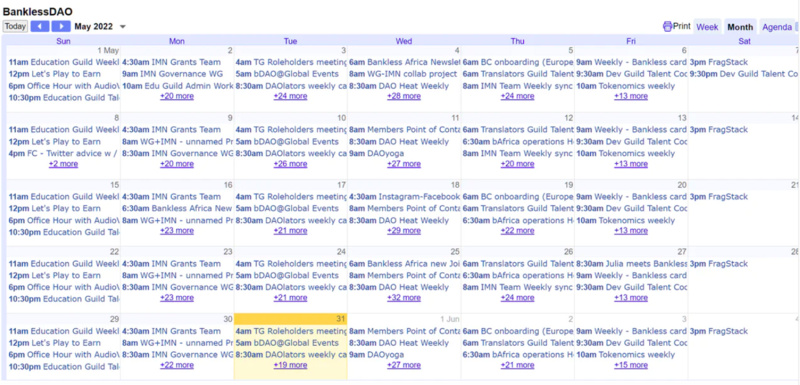
Bankless DAO Meeting Calendar
Experience Forms of Web3 Socializing
Currently, SocialFi and DAO projects face significant issues beyond mechanism design, such as cumbersome usage processes and simplistic interaction forms. In response, we see some traditional social media companies entering Web3 by enhancing social media interaction experiences. For example, Meta is developing interactive 3D experiences, which, compared to text, audio, and video social experiences, will be a major battleground for immersive social experiences in Web3.

Meta's VR Application Horizon Worlds
Additionally, the concept of SocialFi in Web3 social media currently involves different tracks such as the Metaverse, gaming, and the creator economy. Competitors are not only other social media platforms but also projects positioned in the Metaverse, such as The Sandbox and Otherside. This will lead to the interaction experience of Web3 social media being inevitably tied to the Metaverse.
Conclusion
Today’s SocialFi, DAOs, and NFTs provide imaginative spaces for usage scenarios, presenting opportunities for social media dedicated to Web3. Meanwhile, traditional social media is entering a period of slow growth in a saturated market, constrained by the ties of Web2 businesses, and can only observe and test the waters. Rather than seizing the trend, it is more about preparing for self-rescue, as with the launch of more experimental Web3 social products and the iteration of blockchain technology, they will face greater challenges.
The method of self-rescue is to bind interests with Web3 through NFTs, acquiring Web3 user groups to prevent being eliminated in the tide of change. At the same time, in the war against competitors, using NFTs as weapons will create a threat. Whether issuing their own NFTs, utilizing PASS to expand partnerships, or actively holding quality NFTs to explore new markets and gain first-mover advantages in Web3, this will create a dimensional strike effect against competitors.
The future of content distribution models and interaction experiences will change. When NFTs and DAOs fully play their roles and integrate into the SocialFi system, when Metaverse scenarios gradually take shape, and when people rethink and redefine the term "social media," only then will "social media" have truly entered the Web3 era, and the term "social media" will become a thing of the past.











